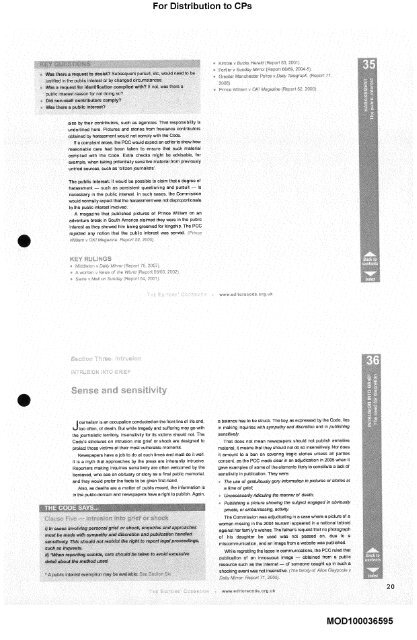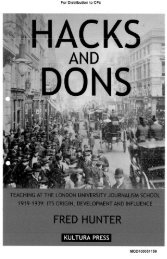The Edi ' - The Leveson Inquiry
The Edi ' - The Leveson Inquiry
The Edi ' - The Leveson Inquiry
Create successful ePaper yourself
Turn your PDF publications into a flip-book with our unique Google optimized e-Paper software.
also by their contributors, such as agencies. That responsibility is<br />
underlined here. Pictures and stories from freelance contributors<br />
obtained by harassment would not comply with the Code,<br />
If a complaint arose, the PCC would expect an editor to show how<br />
reasonable care had been taken to ensure that such material<br />
complied with the Code, Extra checks might be advisable, for<br />
example, when taking potenfially sensitive mataria] from previously<br />
untried sources, such as ’citizen journalists’.<br />
For Distribution to CPs<br />
<strong>The</strong> public Jntereat; It would be possible to claim there degree oi<br />
harassment -- such as persistent questioning and pursuit -- is<br />
necessary n the oublic interest. In such cases, the Comm sslon<br />
would normally expect that the harassment was not dlspmpertienato<br />
to the public interest involved.<br />
A magazine that published pictures of Prince William on an<br />
adventure break in South America claimed they were in the public<br />
interest as they showed him being groomed for kingship. <strong>The</strong> PCC<br />
rejected any notion that the public interest was served. ~fs,~-~;.~f:~<br />
ournalism ~s an occupation conducted on the front line of life and,<br />
~,~ too often, of death. But while tragedy and suffering may go with<br />
the journalistic territory, insensitivity for its victims should not. <strong>The</strong><br />
Code’s stoctures on intrusion into grief or shock are designed to<br />
protect those victims at their most vulnerable moments.<br />
Newspapers have e job to do at such times and most do it well.<br />
It is a myth that approaches by the press are mnerentty intrusive.<br />
Reporters making inquiries sensitively are often welcomed by the<br />
bereaved who see an obituary or story as a final public memoria<br />
and they wou,d prefer the facts to be given first-hand,<br />
Also, as deaths ere a matter of public record, the information is<br />
in the public domain and newspapers nave e right to publish. Again,<br />
a balance has to be struck <strong>The</strong> key as expressed by the Code. lies<br />
~n making mqulnes with sympefhy and discretion and in publishing<br />
sensitively,<br />
That does not mean newspapers should not publish sensitive<br />
material, it means that they should not do so insensitively. Nor does<br />
it amount to a ban on covenng tragic stories unless a parties<br />
consent, as the PCC made clear in an adjudication in 2005 when it<br />
gave examples of some of the elements likely to constitute a tack of<br />
sensitivity in publication. <strong>The</strong>y were:<br />
<strong>The</strong> use of gratuitously gory information in pictures or stories at<br />
a time of grief,<br />
Unnecessarily Mdiculthg the menner of death;<br />
. Pubfishing a picture showing the subject engaged in obviously<br />
MOD100036595
















